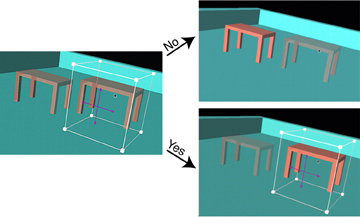

Object Contention Control

|
|
In order to prevent simulator sickness or a loss of feeling of control (as when an environment responds to a user's actions sluggishly) methods are required to deal with latency in a telecollaborative environment. Through the use of particular visual effects, we are able to provide immediate feedback to each participant, even when the network prevents information more useful than the fact that delays are occurring. When updates are finally received, we use the same effects to provide coherent updates to the user's information, without the jarring discontinuities that otherwise would confuse a participant's understanding of the environment. Transparency can be used when manipulating a shared object whose lock has not yet been acquired from the remote computer. Two copies of the object are used, one that follows the user's manipulations and one that remains where the object will be if the lock fails. Both objects are drawn transparent, indicating that both are tentative. If the lock is acquired, the copy the user is manipulating becomes solid and the other copy fades out. If the lock is not acquired, the copy the user is manipulating fades out while the other copy becomes solid . We call this technique "ghost locking". Ghost locking makes the user aware of many aspects of manipulating a shared object in a networked environment. The user has an immediate response to her actions, affording a feeling of control over the environment. She also sees immediately that lag is occurring, because of the appearance of a "partial" or transparent object. Finally, fading out the copy that lost the lock gives the user time to understand the changed state of the manipulated object.
|
Telecollaboration Bibliography
| Home | Research | Outreach | Televideo | Admin | Education |